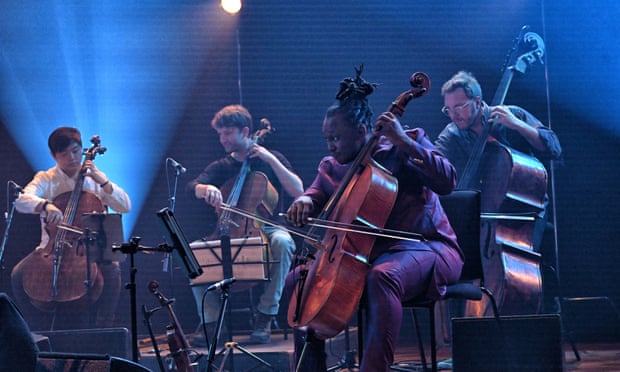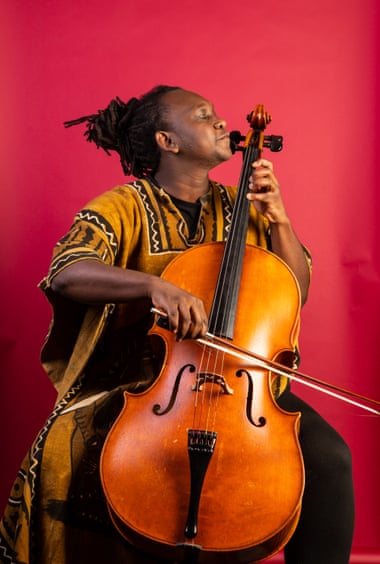Abel Selaocoe walks into a bar in King’s Cross, London, with a small suitcase and a large, curvaceous silver case. “I’m sorry, sir, but you’re going to have to put that in the cloakroom,” the waitress says. “I can’t – it’s my life,” Selaocoe exclaims, and gives her a winning smile. She tries to insist, and watches, bemused, as he steers both cases into a corner. It is about his life that we are here to talk – his extraordinary journey from growing up in a township outside Johannesburg to becoming a classical cellist of international renown and a singer, composer and improviser of dazzling originality. Selaocoe (pronounced Se-lau-chay) has developed a music of his own into which he pours everything he is, his South African heritage and his ideas about life. His cello is a multitasker, often a percussion instrument. And when the cello is not supplying the percussion, Selaocoe uses his extraordinary voice instead: full of melodious yearning one moment, growling as if disinterred – an ancestral voice – the next.
I heard him play at Bold Tendencies, in Peckham, in a show called One-Man Medicine that could, given its effect on his audience, have been medicine for the masses. In a mulberry suit, dreadlocks swept up into a ponytail, he bent over his cello with intent concentration as if in conversation with it, his face reacting to every note: impish, frowning, radiant… His classical training seems like a safety net for the soul. At the end, the audience rose to their feet as one. Later this year, Selaocoe will perform at the Lucerne festival (for the classical elite) and at Womad. He is equally celebrated for his charismatic musicianship in both worlds. He has also recently been made an artist in residence at the Southbank Centre, and in September releases his debut album, Where Is Home (Hae Ke Kae).
Settling into a sofa, Selaocoe explains that home, at the beginning, was Sebokeng, “a big township to the south of Johannesburg. I’m from zone 7 – Skelemeng.” There was a lot of singing in the house and his brother, Sammy – eight years older – played bassoon. On Saturdays, Sammy would take him to the African Cultural Organisation of South Africa, an outreach school run by Michael Masote, “the South African godfather of classical music”. Selaocoe started playing the recorder but was attracted to the cello because, he admits, it was “big” (a little boy’s fancy). The size must have seemed less of a bonus when the brothers had to lug the instrument nine miles to and from the station from which they travelled to Soweto.
The music school was popular with parents, he recalls, because it got children out of the township. But from the start, Sammy was serious about practising, and encouraged Abel to follow suit. Primary school would end at 2pm, they would walk the miles home, arrive at 4.30pm, watch a cartoon and then practise from 5pm to 8pm. Sammy told him: “Nobody goes through it with you, you have to do it yourself.” He’d add: “Just close the door, man, see what happens.”
What happened was that Selaocoe won a scholarship to attend South Africa’s equivalent to Eton: St John’s College, Johannesburg. Mary Selaocoe, his mother, did not live at home. She worked as a cleaner and lived in the quarters of a well-off family. In a YouTube mini-documentary, her employers, Rosheen and Chris de Kock, recall their disbelief on learning that their maid’s son was going to St John’s College. Their incredulity seems insulting now but could not, sadly, at that moment in South Africa’s history, be described as misplaced. Mary Selaocoe emerges as an exceptionally dedicated person: “She was raising two sets of children from different worlds: her own and those of her employer,” her son says, marvelling. She worked unflaggingly, supplementing her income by selling fruit and vegetables and sewing to support her children. He adds: “I have so much gratitude to my mother.”
At 13, Selaocoe was the only township boy at St John’s (he is 30 now), but was undaunted: “It was hugely exciting – a lifestyle of comfort in comparison with the township. And there was the prospect of making friends with people who were not like me, which was what we’d always dreamed of.” He is indebted to the school for “the habits that have kept me going. Like sportsmen, we were taught to understand when to practise, when not to, when to rest our muscles and how to understand where our motivation comes from.”
In 2010 another door opened: Selaocoe won a place at the Royal Northern College of Music in Manchester (where he now lives). He enjoyed it, “although there are a lot of rules I’ve had to unlearn to gain certain freedoms”. He especially cherishes the cello’s “ability to shapeshift”. Not only is it percussive, he says, it can be a “chanting” instrument. Asked about his musical tastes, he is thrown (they are wide) but picks out Bach’s C major Suite and “that sense of perspective in the Prelude – of going through all these other keys while you stay in the same space”. He sees groove as related: “If you’re a classical musician, you’ll say groove is a rhythm that repeats itself, but that is completely untrue – the perspective changes each time you do it.” And he loves ritualistic music: Tavener’s The Protecting Veil and Wagogo music from Tanzania.
His mother’s employers paid for her to come and hear her son at Manchester’s Bridgewater Hall. What did she make of seeing him play? “I find this hard to answer. She was fascinated by the place but one thing she advocates for is groundedness. When she sees a lot of people, she has this idea that you can easily be taken by the current. She was really happy to see me but said: ‘Stay on the ground.’” For Selaocoe, the greatest challenge in staying grounded has been to do with self-belief: “Understanding I was significant has been difficult because there is a romanticising of the west in South Africa – it’s seen as the mecca of classical music. I needed to understand that what I possess is full of abundance, and that not many people express themselves this way. There was a lot of fear when I arrived.” When he asks himself what his musical purpose is, he finds the answer in a Zulu word: sithunyiwe. “It means ‘we have been sent by the ancestors’.”

And then came the pandemic. “There were some truly dark times where I felt cooped up. But if you come from the township, you’re taught how and where to direct hardship. For me, that meant into playing. It was like taking a long look in the mirror – the mirror was improvisation.” Every day, he still has “a few minutes of improvisational flow where I do not stop or impose judgment. It often starts with the voice, and if I don’t like it, I just carry on until I find the flow… I love improvisation because we can always have a fresh conversation. And I love composition because it’s everywhere. It’s waiting for you to take it. It’s about being conscious of what could be.”
The theme of his new album is solitude, and I want to double-check on the nature of that solitude. I’ve heard of the existence of a girlfriend, a viola player with Manchester Collective? “You do your research, man!” he laughs, but does not elaborate. How then would he answer his album’s question today – has the idea of home changed? “As an African cellist, I’ve always been looking for a home. But home is not a geographical space, it’s the places in life that empower you – and these are not always comfortable.”
It is not until the end of our conversation that Selaocoe introduces me to the cello that has slumbered in the corner throughout: “It’s a copy of an old Montagnana,” he enthuses, “made for me by [renowned cello-maker] Robin Aitchison.” He explains there is a garnish of “small grains of sand” in the wood to help the sound “come out as percussive”. When he first played this cello, it was not love at first sound because it seemed too loud. But today they are bonded: “It’s about understanding each other,” he offers. I tell him that watching him play, the cello seems a natural extension of his body, and he smiles. “That’s the hope,” he says.

